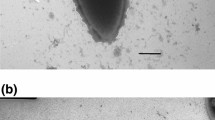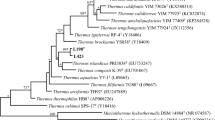Abstract
Fourteen strains of a thermophilic, rod-shaped, peritrichously flagellatedClostridium species were isolated from various mud and soil samples. Round to slightly oval spores were formed in terminal position. The isolates were obligate anaerobes and grew chemolithotrophically with H2 plus CO2 as well as chemoorganotrophically with fructose, glucose, glycerate, or methanol. Under both conditions, acetate was the only organic fermentation product formed in significant amounts. The pH optimum for growth was 5.7; the marginal temperatures for growth wereT min, 36°C;T opt, 56–60°C; andT max, 69/70°C. The DNA contained 53–55 mol% guanine plus cytosine. the isolated strains form a new clostridial species; the nameClostridium thermoautotrophicum is proposed.
Similar content being viewed by others
Literature Cited
Andreesen, J. R., Gottschalk, G., Schlegel, H. G. 1970.Clostridium formicoaceticum nov. spec. Isolation, description and distinction fromC. aceticum andC. thermoaceticum. Archiv für Mikrobiologie72:154–174.
Balch, W. E., Schoberth, S., Tanner, R. S. 1977.Acetobacterium, a new genus of hydrogen-oxidizing, carbon-dioxide-reducing, anaerobic bacteria. International Journal of Systematic Bacteriology27:355–361.
Beuscher, N., Mayer, F., Gottschalk, G. 1974. Citrate lyase fromRhodopseudomonas gelatinosa: Purification, electron microscopy and subunit structure. Archives of Microbiology100:307–328.
Braun, M., Mayer, F., Gottschalk, G. 1981.Clostridium aceticum (Wieringa), a microorganism producing acetic acid from molecular hydrogen and carbon dioxide. Archives of Microbiology128:288–293.
Braum, M., Schoberth, S., Gottschalk, G. 1979. Enumeration of bacteria forming acetate from H2 and CO2 in anaerobic habitats. Archives of Microbiology120:201–204.
De Ley, J., Cattoir, H., Reynaerts, A. 1970. The quantitative measurement of DNA hybridization from renaturation rates. European Journal of Biochemistry12:133–142.
Fontaine, F. E., Peterson, W. H., McCoy, E., Johnson, M. J., Ritter, G. J. 1942. A new type of glucose fermentation byClostridium thermoaceticum n. sp. Journal of Bacteriology43:701–715.
Holdeman, L. V., Cato, E. P., Moore, W. E. C. 1977. Anaerobe laboratory manual, 4th ed. Blacksburg, Virginia: Virginia Polytechnic Institute.
Ljungdahl, L. G., Andreesen, J. R. 1974. Reduction of CO2 to acetate in homoacetate fermenting clostridia and the involvement of tungsten in formate dehydrogenase. In: Schlegel, H. G., Gottschalk, G., Pfennig, N. (eds.), Microbial production and utilization of gases. Göttingen: Goltze.
Marmur, J. A. 1961. A procedure for the isolation of deoxyribonucleic acid from micro-organisms. Journal of Molecular Biology3:208–218.
Marmur, J. A., Doty, P. 1962. Determination of the base composition of deoxyribonucleic acid from its thermal denaturation temperature. Journal of Molecular Biology5:109–118.
Ohwaki, K., Hungate, R. E. 1977. Hydrogen utilization by clostridia in sewage sludge. Journal of Applied and Environmental Microbiology33:1270–1274.
Paynter, M. J. B., Hungate, R. E. 1968. Characterization ofMethanobacterium mobilis, sp. n. isolated from bovine rumen. Journal of Bacteriology95:1943–1951.
Prins, R. A., Lankhorst, A. 1977. Synthesis of acetate from CO2 in the cecum of some rodents. FEMS Microbiology Letters1:255–258.
Wiegel, J., Ljungdahl, L. G., Rawson, J. R., 1979. Isolation from soil and properties of the extreme thermophileClostridium thermohydrosulfuricum. Journal of Bacteriology139:800–810.
Wieringa, K. T. 1936. Over het verdwijnen van waterstof en koolzuur onder anaerobe voorwaarden. Antonie van Leeuwenhoek Journal of Microbiology and Serology3:263–273.
Wieringa, K. T. 1940. The formation of acetic acid from carbon dioxide and hydrogen by anaerobic spore-forming bacteria. Antonie van Leeuwenhoek Journal of Microbiology and Serology6:251–262.
Wolin, E. A., Wolfe, R. S., Wolin, M. J. 1964. Viologen dye inhibition of methane formation byMethanobacillus omelianskii. Journal of Bacteriology87:993–998.
Author information
Authors and Affiliations
Rights and permissions
About this article
Cite this article
Wiegel, J., Braun, M. & Gottschalk, G. Clostridium thermoautotrophicum species novum, a thermophile producing acetate from molecular hydrogen and carbon dioxide. Current Microbiology 5, 255–260 (1981). https://doi.org/10.1007/BF01571158
Issue Date:
DOI: https://doi.org/10.1007/BF01571158




